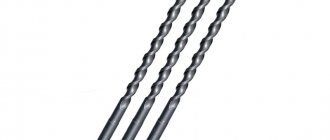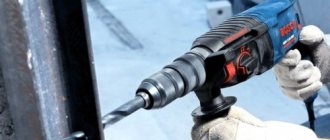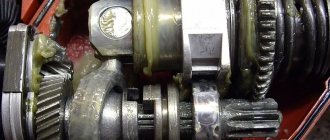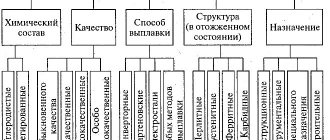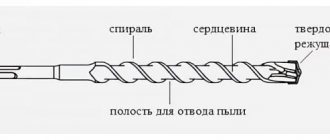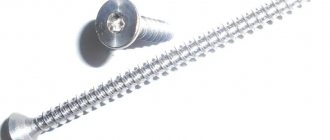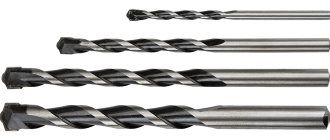products for professionals from professionals
Diager drills and bits are products for professionals in the field of drilling, manufactured at the Diager concern plant in France. Steel from Germany is used in the production of drills; carbide tips are manufactured at the Ceratizit plant in Luxembourg (supplier of all European premium drill manufacturers).
The main advantages of Diager drills are strength, long service life, speed and drilling accuracy. PGM certified
, which means they are ideal for drilling holes for mechanical anchors of the same standard.
Below we will talk about Diager drills designed for drilling reinforced concrete.
- New for 2022 – sds-max Ultimax 646 drill with a monolithic carbide tip. Specially designed for powerful rotary hammers. The manufacturer claims that the drills penetrate reinforcement up to ø22 mm
, with an average
life of 150 m
in C50 concrete.
We decided to put these drills to the test and conducted our own little test:
| Materials and equipment: Drill Ultimax646 25*540mm Hammer drill Bosch GBH 8-45 Reinforced concrete block 400mm thick, reinforcement diameter 20mm in one layer Results: Drilling was carried out in the center of the reinforcement. The drill passed through the reinforcement in 8 minutes (4+4, break for 1 minute for cooling). Feel: The drill is perfectly balanced, vibration is low, and you feel comfortable while drilling. When passing through the reinforcement, the drill works like a drill for metal, removing short chips. Conclusion: The drill has proven itself to be excellent when drilling reinforced concrete, but for serial drilling of reinforcement we recommend using diamond core bits. |
The Booster Plus drill for light hammer drills (SDS-plus shank) has no analogues - a monolithic three-beam pobedit tip with complex sharpening angles and a chisel effect resists reinforcement. The manufacturer declares an amazing resource: up to 1500 holes
in concrete grade B50!
The square spiral spiral has three channels combining passage, compression and depression chamber for accelerated removal of slurry. The drill is indispensable when the finishing work has already been completed - it drills perfectly round holes
and ensures
reliable fixation of the fasteners
.
The B3max reinforced concrete drill is designed for heavy hammer drills (SDS-max shank) and is similar in tip and spiral design to the Booster Plus drills.
| When hitting the reinforcement, the loads are distributed in a certain way, which allows the Booster Plus and B3Max drills to pass through the reinforcement without jamming. |
| Booster Plus drills: 1. Drill reinforced concrete. There is a comparison of two drills: with two cutting edges and three cutting edges (Booster Plus). Booster Plus maintains the drilling axis and confidently passes through reinforcement. 2. They have a very long service life (up to 1500 holes) 3. They drill perfectly straight holes thanks to the three-beam tip and the self-centering effect. This ensures reliable fixation of the fastener. |
The Ultimax reinforced concrete drill for SDS-max rotary hammers is the predecessor of the Ultimax 646. The Ultimax has increased strength and bending resistance. High temperature finishing ensures the strength of the tungsten tip. The unique anti-blocking system reduces the risk of the drill jamming in particularly hard and reinforced materials. Ultimax drills are suitable for drilling materials such as reinforced concrete, granite, stone, brick. The service life of the Ultimax drill is also stated to be impressive: up to 1000 holes
in concrete grade B50!
After the appearance of the Ultimax 646 drills, its predecessor will gradually leave the market. However, ø32 mm will remain in production. These drills have found application in the development of gold deposits in South America, and there is no better solution yet.
| 1. The core of the translational spiral has been strengthened. This increased the stiffness in the area subject to maximum stress (the lower sections of the drill). The strength of the drill allows the energy of the hammer to be transferred without loss. 2. 6 asymmetrical tip edges ensure rapid penetration into the material and minimize the risk of drill jamming in particularly hard and reinforced materials. The rounded progressive spiral ensures rapid removal of cuttings and eliminates the risk of drill jamming due to cutting cuttings being pressed into the hole. 3. The pressure of the hammer drill, coupled with the hardness of the material, creates serious stress on the drill. Special heat treatment of the drill body provides resistance to these loads and concentrates the impact energy on the drill tip. |
| Ultimax: 1. Ease of use - low vibration level 2. Anti-locking system: 6 cutting edges prevent the drill from jamming in the material 3. Accuracy 4. High drilling speed 5. High performance in hard material |
Reminder for working with Diager drills
How to drill reinforcement in concrete? Selecting equipment
Drilling reinforced concrete is a specific operation, very difficult to perform well. This is due to the sharp heterogeneity of reinforced concrete, as well as the uncertainty of the passage of reinforcing bars through the thickness of the material. In this regard, the use of a diamond drill can cause cracking in the tool, and a high-speed steel drill will have low durability.
Characteristic differences of modern models
Due to the fact that construction work cannot be done without drilling floors, walls, ceilings, furniture and other materials, it is necessary to worry in advance about purchasing a tool such as a drill for a concrete hammer drill. The 6 mm size is considered the most advantageous, as it copes well with all tasks in the household sphere. In addition, such a device can be used as a jackhammer. Against this background, it is important to note that all modern drills differ from each other in certain characteristics:
- Type of internal cavity of the drill.
- Number of built-in cutting edges.
- Features of the structure of the spiral.
- The alloy that was used to make the main part.
A high-quality drill differs from a regular drill in that it has a shank that ensures reliable fixation in the hammer drill.
It is due to this that dust and small particles of the material that has been drilled are eliminated without interfering with the stable operation of the tool.
As for consumers, they must take into account two main criteria on which the functionality and reliability of the purchased tool depends: diameter and length. The ability of the drill to make optimal holes in solid material depends on the length. Each manufacturer necessarily takes into account all the features of using the tool, so every buyer can purchase a model with a reinforced type of construction, double spiral shape.
Such units are characterized by a long service life and high quality of work performed. Numerous advantages of drills are associated with the fact that they are made of high-strength VK8 alloy. Thanks to this, specialists can process materials of increased strength.
Fundamentals of drilling technology for reinforced concrete reinforcement
To achieve a positive result - the absence of cracks and chips in reinforced concrete - it is worth remembering a few rules:
- Clear marking of all drilling locations with markings at once.
- Use of personal protective equipment - a dust mask that fits tightly to the face, headphones and goggles. Work only with protective gloves.
- The space around the future hole is covered with plastic film. All existing ventilation openings should also be closed.
- For drilling reinforced concrete, it is recommended to use drills made of hard alloys of the VK type with a minimum percentage of cobalt. The physical and mechanical characteristics of such alloys are given below:
| Brand | Bending strength, MPa, not less | Rockwell hardness, HRA, no less | Density, g/cm 3 |
| VK2 | 1000 | 90,0 | 15,0…15,4 |
| VK3 | 1000 | 89,0 | 14,9…15,3 |
| VK3M | 1100 | 91,0 | 15,0…15,3 |
- The diameter of the drill bit for the reinforcement should correspond to the diameter of the future hole. Impact drills are used for drilling, and the rotation speed of the chuck with the drill should be the minimum permissible.
- The depth limiter on the hammer drill is set 5...10 mm deeper than the length of the drill. If there is no scale on the instrument. For marking, you can wrap a strip of colored tape around the bat.
- The drill feed at the initial moment of drilling should be minimal, then, upon reaching the steel, the feed and speed are increased, periodically clearing the drilling area of dust.
- If a blind hole is drilled, then to control the depth and quality of drilling, it is recommended to insert a hose with a nozzle connected to a compressor into the cavity and clear the cavity of any remaining material.
Carbide drills get very hot when drilling concrete, but this is not a disadvantage. However, due to the sudden change in drilling conditions for concrete and reinforcement, the durability of the drill is low in any case. The length of the working part of the drill should be chosen such that after drilling is completed, at least 20...30 mm of the drill body remains above the bit.
Surface preparation
Before operating the device, you need to check whether there are any communications on the area of the selected surface. If you neglect this rule, you can damage the electrical wiring or the place where the pipe passes. A metal detector will help the worker cope with this task, since when it detects non-ferrous metals, iron or steel, it gives a specific signal.
If the selected section of the concrete wall meets all the requirements, then you need to mark a point and then begin operating the device.
The intended drilling location should be marked with a pencil.
How to choose a drill for drilling reinforcement in concrete?
The initial characteristic is the diameter of the hole, as well as the shape of the landing part. In this case, the drill is always designed for one-sided drilling, since for concrete surfaces it is almost impossible to align the axes of two holes that are drilled from opposite sides of the slab, wall or block.
How to drill reinforcement in concrete? In one pass, it is usually possible to obtain holes in the reinforcement if the maximum diameter of the cavity does not exceed 10...12 mm; in all other cases, preliminary drilling is performed first, and then reaming.
The choice of the size of the impact drill decides a lot. The disadvantage of a rotary hammer is that it sharply increases the level of vibration, and this will negatively affect the accuracy of the resulting hole. Considering that reinforced concrete has no plasticity, this circumstance will “help” break a hole or break off a piece of concrete along with under-drilled reinforcement.
Do I need to use a core or a bit? Experts think so. In addition, an impact drill with a rebar drill must be installed on a massive stand (or a tripod - when making vertical holes in the ceiling).
The best quality is obtained from hollow drill cores for reinforced concrete. They penetrate into the foundation only along the perimeter of the bit, leaving a cylindrical volume of concrete inside the tool. This piece is removed after drilling or periodically broken into pieces to ensure smooth operation of the drill. Drilling reinforcement in this way can be dry or wet (the second is preferable).
You've almost drilled to the required depth and you can't go any further.
Almost - this means, for example, for a depth of 5 cm you underdrilled 5 mm.
Then you hit something. There are rare cases when you come up against something major, for example, some hard monolithic cobblestone that cannot really be drilled out or crushed in any way. If the self-tapping screw on which you are going to hang the structure does not have strict load requirements, then try taking the same self-tapping screw, but 5 mm shorter, and simply cut the dowel, which is not fully inserted into the hole and sticks out with a small end, with a construction knife. as shown in the picture:
Next, just take a self-tapping screw that is 5 mm shorter and screw it into the trimmed dowel. This is not a very good practice, but sometimes there are situations when nothing else can be done and then this is the way out!
Specialized drilling tool
Exclusively for the needs of drilling reinforced concrete, the German company Bosch has developed equipment designs - ProDiager (drill for reinforced concrete) and RebarCutter (drill for rebar).
Features of the ProDiager line:
- Bit diameter, mm - up to 20.
- Durability before resharpening – up to 1000 holes.
- The number of bits in the holder is up to 10.
ULTIMAX's massive compact monoblock head is made from a carbide material similar to VK3, which allows drilling at the highest possible speed. Compatible with all types of powerful impact drills. Suitable for making holes and cavities in reinforced concrete, stone, granite and other materials.
The RebarCutter SDS plus-9 rebar cutter provides cutting of reinforced concrete and reinforcement embedded in reinforced concrete products. With the SDS-plus holder, the cutter can also be installed in conventional rotary hammers.
- The diameters of the resulting holes, mm – 16...32.
- Hole depth, mm – 120…300.
- Maximum tool runout, mm – up to 1.
Stationary models of rebar cutters are also available, which are equipped with a locking trigger switch. This cutter can be powered by a foot pedal, which improves the operator’s working conditions.
Source: proinstrumentinfo.ru
How to drill without dust: options, the better
Construction work is always accompanied by dust and debris, but using some recommendations and tips, it can be significantly reduced:
- During operation, the hammer drill leaves a slight dust, so that it does not fly around the room, use a construction vacuum cleaner at the same time. Some brands of tools have a built-in vacuum cleaner, which makes the task easier;
- using a drill, it is best to either make a jig on the end or a bag, or make an envelope under the hole so that the debris falls into it.
How to drill holes in a brick wall: choosing tools and attachments
To make a hole in a brick wall, a hammer drill with a drill or an impact drill are suitable; the latter is most often used. Its power must be at least 600 watts, the minimum number of revolutions is from 2500 per minute. It is best to use a drill with continuously adjustable power and a quick clamp function.
Using the hammer drilling function, the drill becomes identical to a hammer drill. Increases speed and ease of operation. To make a hole in a brick wall you need to use the dynamic impact method. Without this, the drill will not be able to engage the inside of the brick.
The drills must be victorious. If through drilling is necessary, a drill is used
How to drill a load-bearing wall with a hammer drill in a panel house
In most panel houses, the walls are made of concrete; in order to make a hole with a hammer drill, you need to use pobedit drills.
In addition to them, you can use special crowns. They have soldering around the circumference. When using them, you need to disable the hammer drill's impact function.
Specialists use diamond drilling, which requires powerful equipment and skills.
How to properly drill a reinforced concrete pipe with a hammer drill
When using an impact drill for reinforced concrete, you need to use the “perforator” mode and pobedit drills. First, the hole is made smaller, then larger. The drill needs to be cooled periodically.
Important! When working with concrete, you need to avoid hitting the reinforcement, otherwise the drill will break. Using a special device you can check where it is located
How to make a hole in a concrete wall with a drill
It is difficult to drill into a concrete wall with a conventional drill. You need to install victory drills and select low speeds. A dowel is inserted into the desired location to help the tool pierce the surface. Next, drilling should be alternated with striking the dowel.
The drill must be constantly cooled, otherwise it will burn.
If the drill does not have a speed control, then it will not be possible to make a hole.
How to make a hole in a concrete wall in an apartment with a drill
For a small hole, you can use a punch. Most conveniently, it can be made from a drill, 8 mm in diameter. The end is sharpened sharply. The drill is placed in the desired place, rotated, while simultaneously hitting it with a hammer. Wet the drill periodically to make it work longer.
Concrete drills
SDS drills provide high drilling speed and long service life when working in concrete, masonry and other mineral materials
Our customer service department will contact you within a few minutes.
The browser window was open in chat mode. Please continue your conversation there.
Our customer service department will contact you within a few minutes.
The browser window was open in chat mode. Please continue your conversation there.
Please note: quantities are automatically rounded based on packaging multiples.
Please note: quantities are automatically rounded up to match the packaging multiple.
Hilti = registered trademark of Hilti Corporation, 9494 Schaan, Principality of Liechtenstein © 2009-2016, Subject to technical and programming changes, SE&O.
Hilti provides cutting-edge technology for construction professionals around the world. Hilti offers products, systems, services, innovative and profitable business solutions to customers in the construction industry.
Source: www.hilti.ru
